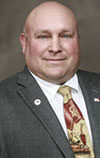Consumers have certainly supported the beef industry for decades, and, as a producer, I believe we must take their concerns very seriously – even when that includes their questions about how my livelihood as a rancher affects the environment.
Over the past two decades, our industry has made significant efforts to decrease its impact on the earth. As a result, today’s beef farmers and ranchers are producing more food with far fewer resources. In fact, the U.S. is the global leader in growing beef with the least environmental impact.
An animal life cycle assessment conducted by the USDA’s Agricultural Research Service and the beef checkoff shows that data commonly associated with beef’s environmental impact in the U.S. is often overestimated. As a comprehensive beef lifecycle assessment, the report showed beef production is responsible for only 1.9% of greenhouse gas emissions in the U.S. This is dramatically lower than the misrepresented global livestock figure of 14.5%. Furthermore, beef producers can now deliver the same amount of beef with one-third fewer cattle than they did in 1977.
Those statistics are very good news, and they show that farmers and ranchers are dedicated to continuously improving their operations. Now more than ever before, consumers care about protecting and preserving the environment, and they’re keeping that in mind when deciding what food to purchase. They’re not just examining where their food comes from, how it tastes and what it’s made of, but also how it was raised. Consumers want to see us produce high-quality beef without depleting our world’s natural resources. As a rancher, I can proudly confirm we’re doing just that.
As cattlemen and women, we must recognize this consumer trend and promote our love of the land from pasture to plate. To support this effort, the beef checkoff is using producer dollars to fund the popular Beef It’s What’s For Dinner brand and show consumers the steps we’ve taken toward beef production with less impact on the environment.
For example, when consumers search for information about beef online, they’re driven to the checkoff-funded www.beefitswhatsfordinner.com. Here, they can watch videos taken on real-life ranches, feedlots and operations, hear directly from farmers and ranchers about their lives, and take a behind-the-scenes look at how we care for our land and animals every single day. In addition, the site has many articles, graphics, and studies that showcase how beef remains a safe and environmentally friendly option for consumers.
The way we look after our land and our livelihood is a never-ending journey. As time marches on, the beef world we live in will continue to improve and decrease its environmental footprint by implementing new technologies and management practices. It is our responsibility to share what we do every day to support a healthy environment for ourselves and our animals.
About the beef checkoff
The Beef Checkoff Program was established as part of the 1985 Farm Bill. The checkoff assesses $1 per head on the sale of live domestic and imported cattle, in addition to a comparable assessment on imported beef and beef products. In states with qualified beef councils, states may retain up to 50 cents of the dollar and forward the other 50 cents per head to the Cattlemen’s Beef Promotion and Research Board, which administers the national checkoff program, subject to USDA approval. ![]()
References omitted but are available upon request. Click here to email an editor.

-
Jared Brackett
- Fifth-Generation Cow-Calf Producer
- Vice Chairman
- Cattlemen’s Beef Board
- Filer, Idaho








